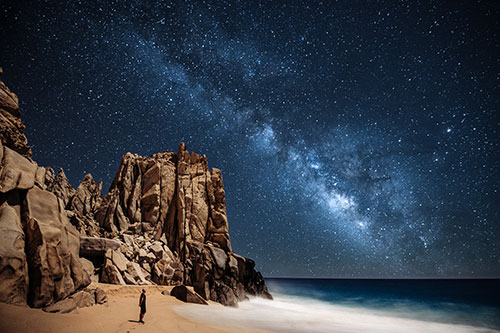 |  |
By Georgia Tanner

Studies in this century estimate that two-thirds of Americans can no longer see the Milky Way from where they live, and two-thirds of the world's people live under light-polluted skies. Look at a satellite map of the Earth at night and you will see the U.S.A. alight almost everywhere; only parts of the interior are dark. Then look at Baja California. Except for the northern and southern ends, the peninsula is black, indicating the absence of light pollution.
The industrial-age phenomenon called light pollution is defined by the International Dark-Sky Association as "any adverse effect of artificial light, including sky glow, glare, light trespass, light clutter, decreased visibility at night, and energy waste." "Sky glow" is the orange-yellow glow above cities and towns whose light fixtures aim some of their light into the sky, and "light trespass" might be that annoying light from a street lamp or neighbor's property that shines into your bedroom. Light trespass occurs when poorly shielded or poorly aimed fixtures cast light into unwanted areas, such as observatory buildings and your bedroom. (There are "dark sky friendly" IDA-approved fixtures that minimize light pollution; look in your local home improvement or hardware store for the IDA Fixture Seal of Approval. The International Dark-Sky Association is slowly making inroads into light pollution. There are International Dark-Sky Parks, Reserves, and Communities. The IDA also has a Practical Guide to Residential Lighting, in Spanish too).

Specified periods of light and dark are essential for good health for life on Earth. Health researchers have established that exposure to artificial light at night, including television and computer screens, reduces the human body's production of melatonin, the hormone that tells the body's organs and systems that it is dark. Other forms of life benefit from dark skies. The combined effects of artificial lights and sky glow on nocturnal species can disrupt the functioning of entire ecosystems. Migrating and local birds may become so confused by lights from towers and buildings that they circle the lights until they die of exhaustion. Coastal lighting leads sea turtle hatchlings away from the ocean. The use of fish-attracting intense light for fishing at night on the ocean or along the shore contributes to overfishing and the decline of fish worldwide.
Living with the rhythms of day and night and the awesome majesty of the stars helps to keep me aware of my small place in the universe. For six years I lived on the northern Gulf about thirty miles south of San Felipe, where all homes are off the grid. The skies are dark at night and everyone can see the Milky Way. I've seen the comet Hale-Bopp and thin slivers of moon before dawn and the green flash riding the sun out of the sea, but nothing was more entrancing than the phenomenon called the zodiacal light.

During the early fall of 2006 the weather was calm and there was no moon in the eastern sky before sunrise; these conditions were perfect for viewing the zodiacal light, also known as the false dawn. That year I slept on the sun deck to avoid the heat of late September. Each night I woke up to see the tall shining triangle of the zodiacal light. This elusive luminosity can be seen about one and a half to two hours beforesunrise, but only during late summer and early fall when the plane of the solar system (the ecliptic) forms a steep angle with the eastern horizon and the moon is absent from the predawn sky. The "false dawn" occurs when sunlight is scattered from dust particles throughout the solar system; the term "zodiacal light" refers to the phenomenon of sunlight following the plane of the planets and appearing to pass through the constellations of the zodiac.
Reading about this light had not prepared me for its size. It ascended nearly 40 degrees above and 15 degrees along the eastern horizon and its glow was as bright as the Milky Way. For two weeks this vision enchanted me. So strong was my desire to see this tall glowing triangle that I always woke up early. Every morning I lay on the deck facing east, filled with peace and happiness, until the zodiacal light faded with the dawn.
Nearly the entire peninsula of Baja offers great star gazing. Once you put a little distance between yourself and any of the larger cities, the light pollution is minimal to none and the sky will light up! A great option is the San Pedro Martir state park and campground.
Satellite photo courtesy of NASA